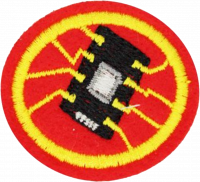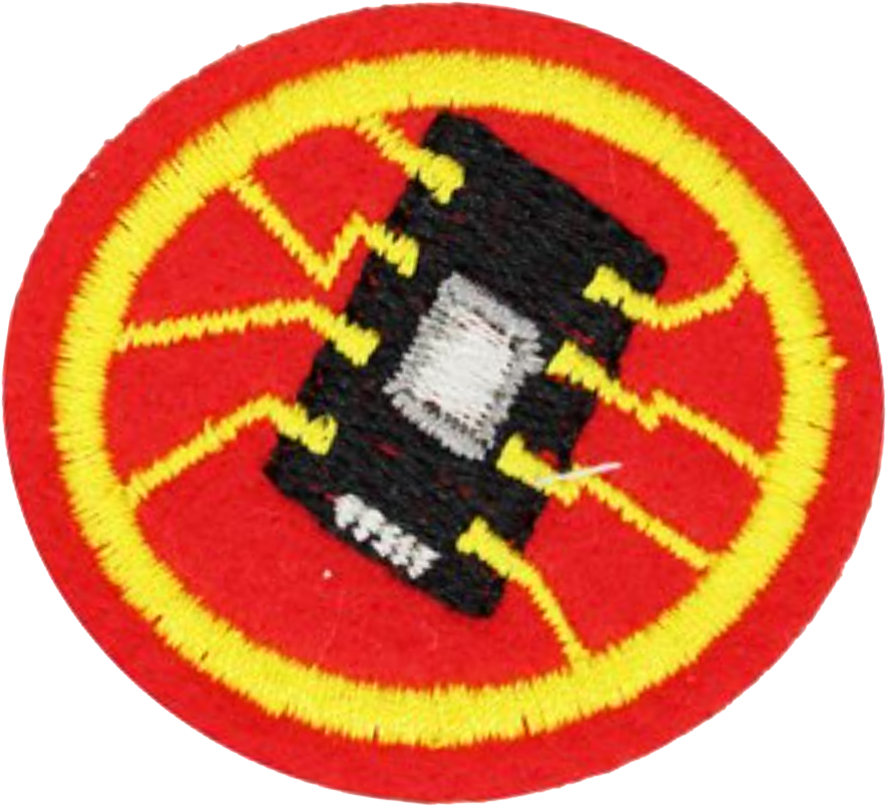Difference between revisions of "AY Honors/Electronics/Answer Key"
From Pathfinder Wiki
< AY Honors | ElectronicsAY Honors/Electronics/Answer Key
(Marked this version for translation) |
m (- Category of AYHAB) |
||
| (4 intermediate revisions by 2 users not shown) | |||
| Line 1: | Line 1: | ||
| − | < | + | {{HonorSubpage}} |
| − | <noinclude><translate><!--T: | + | <section begin="Body" /> |
| + | {{ansreq|page={{#titleparts:{{PAGENAME}}|2|1}}|num=1}} | ||
| + | <noinclude><translate><!--T:26--> | ||
</noinclude> | </noinclude> | ||
| + | <!-- 1. Design a simple schematic diagram, with a brightness sensor that controls the power of a lamp, use the correct symbology to represent each of the elements. --> | ||
| − | <!--T: | + | <!--T:27--> |
| − | {{ | + | <noinclude></translate></noinclude> |
| − | | | + | {{CloseReq}} <!-- 1 --> |
| − | + | {{ansreq|page={{#titleparts:{{PAGENAME}}|2|1}}|num=2}} | |
| − | | | + | <noinclude><translate><!--T:28--> |
| − | | | + | </noinclude> |
| − | | | + | <!-- 2. Demonstrate the correct way to solder and desolder electronic components, as well as the care that must be taken to avoid their deterioration and uselessness. --> |
| − | |||
| − | |||
| − | |||
| − | |||
| − | = | + | <!--T:29--> |
| + | <noinclude></translate></noinclude> | ||
| + | {{CloseReq}} <!-- 2 --> | ||
| + | {{ansreq|page={{#titleparts:{{PAGENAME}}|2|1}}|num=3}} | ||
| + | <noinclude><translate><!--T:30--> | ||
| + | </noinclude> | ||
| + | <!-- 3. What are the main safety rules to follow when handling electronic circuit boards to avoid damaging them? --> | ||
| − | = | + | <!--T:31--> |
| + | <noinclude></translate></noinclude> | ||
| + | {{CloseReq}} <!-- 3 --> | ||
| + | {{ansreq|page={{#titleparts:{{PAGENAME}}|2|1}}|num=4}} | ||
| + | <noinclude><translate><!--T:32--> | ||
| + | </noinclude> | ||
| + | <!-- 4. Research on the development of the incandescent valve: --> | ||
| − | == | + | <!--T:33--> |
| + | <noinclude></translate></noinclude> | ||
| + | {{ansreq|page={{#titleparts:{{PAGENAME}}|2|1}}|num=4a}} <!--T:7--> | ||
| + | <noinclude><translate><!--T:34--> | ||
| + | </noinclude> | ||
| − | == | + | <!--T:35--> |
| + | <noinclude></translate></noinclude> | ||
| + | {{CloseReq}} <!-- 4a --> | ||
| + | {{ansreq|page={{#titleparts:{{PAGENAME}}|2|1}}|num=4b}} <!--T:8--> | ||
| + | <noinclude><translate><!--T:36--> | ||
| + | </noinclude> | ||
| − | == | + | <!--T:37--> |
| + | <noinclude></translate></noinclude> | ||
| + | {{CloseReq}} <!-- 4b --> | ||
| + | {{ansreq|page={{#titleparts:{{PAGENAME}}|2|1}}|num=4c}} <!--T:9--> | ||
| + | <noinclude><translate><!--T:38--> | ||
| + | </noinclude> | ||
| − | == | + | <!--T:39--> |
| + | <noinclude></translate></noinclude> | ||
| + | {{CloseReq}} <!-- 4c --> | ||
| + | {{CloseReq}} <!-- 4 --> | ||
| + | {{ansreq|page={{#titleparts:{{PAGENAME}}|2|1}}|num=5}} | ||
| + | <noinclude><translate><!--T:40--> | ||
| + | </noinclude> | ||
| + | <!-- 5. Make a list of the main units of measurement found in electronics and know how to identify them in each component. --> | ||
| − | == | + | <!--T:41--> |
| + | <noinclude></translate></noinclude> | ||
| + | {{CloseReq}} <!-- 5 --> | ||
| + | {{ansreq|page={{#titleparts:{{PAGENAME}}|2|1}}|num=6}} | ||
| + | <noinclude><translate><!--T:42--> | ||
| + | </noinclude> | ||
| + | <!-- 6. Research what is the N element and what is the P element. What materials are they made of and what do these elements do in electronic devices? --> | ||
| − | == | + | <!--T:43--> |
| + | <noinclude></translate></noinclude> | ||
| + | {{CloseReq}} <!-- 6 --> | ||
| + | {{ansreq|page={{#titleparts:{{PAGENAME}}|2|1}}|num=7}} | ||
| + | <noinclude><translate><!--T:44--> | ||
| + | </noinclude> | ||
| + | <!-- 7. What is a logic gate? Define each of the following gates, illustrating them: --> | ||
| − | == | + | <!--T:45--> |
| + | <noinclude></translate></noinclude> | ||
| + | {{ansreq|page={{#titleparts:{{PAGENAME}}|2|1}}|num=7a}} <!--T:13--> | ||
| + | <noinclude><translate><!--T:46--> | ||
| + | </noinclude> | ||
| − | == | + | <!--T:47--> |
| + | <noinclude></translate></noinclude> | ||
| + | {{CloseReq}} <!-- 7a --> | ||
| + | {{ansreq|page={{#titleparts:{{PAGENAME}}|2|1}}|num=7b}} <!--T:14--> | ||
| + | <noinclude><translate><!--T:48--> | ||
| + | </noinclude> | ||
| − | == | + | <!--T:49--> |
| + | <noinclude></translate></noinclude> | ||
| + | {{CloseReq}} <!-- 7b --> | ||
| + | {{ansreq|page={{#titleparts:{{PAGENAME}}|2|1}}|num=7c}} <!--T:15--> | ||
| + | <noinclude><translate><!--T:50--> | ||
| + | </noinclude> | ||
| − | == | + | <!--T:51--> |
| + | <noinclude></translate></noinclude> | ||
| + | {{CloseReq}} <!-- 7c --> | ||
| + | {{ansreq|page={{#titleparts:{{PAGENAME}}|2|1}}|num=7d}} <!--T:16--> | ||
| + | <noinclude><translate><!--T:52--> | ||
| + | </noinclude> | ||
| − | == | + | <!--T:53--> |
| + | <noinclude></translate></noinclude> | ||
| + | {{CloseReq}} <!-- 7d --> | ||
| + | {{ansreq|page={{#titleparts:{{PAGENAME}}|2|1}}|num=7e}} <!--T:17--> | ||
| + | <noinclude><translate><!--T:54--> | ||
| + | </noinclude> | ||
| − | == | + | <!--T:55--> |
| + | <noinclude></translate></noinclude> | ||
| + | {{CloseReq}} <!-- 7e --> | ||
| + | {{CloseReq}} <!-- 7 --> | ||
| + | {{ansreq|page={{#titleparts:{{PAGENAME}}|2|1}}|num=8}} | ||
| + | <noinclude><translate><!--T:56--> | ||
| + | </noinclude> | ||
| + | <!-- 8. Know what diodes are and know how they work. --> | ||
| − | == | + | <!--T:57--> |
| + | <noinclude></translate></noinclude> | ||
| + | {{CloseReq}} <!-- 8 --> | ||
| + | {{ansreq|page={{#titleparts:{{PAGENAME}}|2|1}}|num=9}} | ||
| + | <noinclude><translate><!--T:58--> | ||
| + | </noinclude> | ||
| + | <!-- 9. Project, design, prepare and assemble a printed circuit board. --> | ||
| − | == | + | <!--T:59--> |
| + | <noinclude></translate></noinclude> | ||
| + | {{CloseReq}} <!-- 9 --> | ||
| + | {{ansreq|page={{#titleparts:{{PAGENAME}}|2|1}}|num=10}} | ||
| + | <noinclude><translate><!--T:60--> | ||
| + | </noinclude> | ||
| + | <!-- 10. Build a simple AM or FM receiver and understand how it works. --> | ||
| − | == | + | <!--T:61--> |
| + | <noinclude></translate></noinclude> | ||
| + | {{CloseReq}} <!-- 10 --> | ||
| + | {{ansreq|page={{#titleparts:{{PAGENAME}}|2|1}}|num=11}} | ||
| + | <noinclude><translate><!--T:62--> | ||
| + | </noinclude> | ||
| + | <!-- 11. Demonstrate the correct use of the most common measuring tools and devices in an electronics laboratory (oscilloscope, multimeter, etc.). --> | ||
| − | == | + | <!--T:63--> |
| + | <noinclude></translate></noinclude> | ||
| + | {{CloseReq}} <!-- 11 --> | ||
| + | {{ansreq|page={{#titleparts:{{PAGENAME}}|2|1}}|num=12}} | ||
| + | <noinclude><translate><!--T:64--> | ||
| + | </noinclude> | ||
| + | <!-- 12. Know the main areas of application of electronics and explain one of them. --> | ||
| − | == | + | <!--T:65--> |
| + | <noinclude></translate></noinclude> | ||
| + | {{CloseReq}} <!-- 12 --> | ||
| + | {{ansreq|page={{#titleparts:{{PAGENAME}}|2|1}}|num=13}} | ||
| + | <noinclude><translate><!--T:66--> | ||
| + | </noinclude> | ||
| + | <!-- 13. Build a PC remote control. --> | ||
| − | + | <!--T:67--> | |
| − | + | <noinclude></translate></noinclude> | |
| − | + | {{CloseReq}} <!-- 13 --> | |
| − | + | {{ansreq|page={{#titleparts:{{PAGENAME}}|2|1}}|num=14}} | |
| − | + | <noinclude><translate><!--T:68--> | |
| + | </noinclude> | ||
| + | <!-- 14. Build an AC wattmeter for appliances. --> | ||
| + | <!--T:69--> | ||
| + | <noinclude></translate></noinclude> | ||
| + | {{CloseReq}} <!-- 14 --> | ||
| + | <noinclude><translate></noinclude> | ||
==References== <!--T:25--> | ==References== <!--T:25--> | ||
| − | |||
<noinclude></translate></noinclude> | <noinclude></translate></noinclude> | ||
| + | {{CloseHonorPage}} | ||
Latest revision as of 16:26, 14 July 2022
1
Design a simple schematic diagram, with a brightness sensor that controls the power of a lamp, use the correct symbology to represent each of the elements.
2
Demonstrate the correct way to solder and desolder electronic components, as well as the care that must be taken to avoid their deterioration and uselessness.
3
What are the main safety rules to follow when handling electronic circuit boards to avoid damaging them?
4
Research on the development of the incandescent valve:
4a
How was it discovered?
4b
What uses did it have?
4c
What elements did its inventor use?
5
Make a list of the main units of measurement found in electronics and know how to identify them in each component.
6
Research what is the N element and what is the P element. What materials are they made of and what do these elements do in electronic devices?
7
What is a logic gate? Define each of the following gates, illustrating them:
7a
AND
7b
OR
7c
NOR
7d
NAND
7e
XOR
8
Know what diodes are and know how they work.
9
Project, design, prepare and assemble a printed circuit board.
10
Build a simple AM or FM receiver and understand how it works.
11
Demonstrate the correct use of the most common measuring tools and devices in an electronics laboratory (oscilloscope, multimeter, etc.).
12
Know the main areas of application of electronics and explain one of them.
13
Build a PC remote control.
14
Build an AC wattmeter for appliances.



